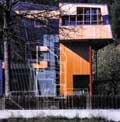Maison individuelle, Zirl Autriche, 1997






|
The Poor Boys Enterprise | Marie Thérèse Harnoncourt (*1967)| Florian Haydn (*1967) | Ernst J. Fuchs (*1963) FRAGMENTS TRASHPOETRY — The preoccupation with the NOW — not the construction of a specific image as the goal, but the use of conditions/states are the parameters for requirements, usage, form and aesthetics. Rubbish bins, waste-paper baskets, data banks and plots of land, cities are treasure troves. We develop FRAGMENTS (beginnings). Fragments are the trigger for activity. We condense the field, the field of possibilities that have to be drawn from the user. Possibilities are the result of seeing, thoughts, ideas (...). A fragment contains all possibilities within itself. There is no letting things get done. The user's doing affects the atmosphere. The fragment is an impulse, a motivation. In connection with other fragments, they come to life. We attach our vision — (hopes) of building — to working with fragments. Buildings are to be entirely different from one another. Dreams and wishes develop inspiration. Grow, starting without knowing what something is. 'DATAFIELD' Zirl DESIGN/BUILDING — We want emancipation from design's being a speculation on a possible prospective act of building. The design is the opportunity to fill the selected field with ideas. The enrichment with ideas results in a spatial source of nutrition, this forms the communicative base for later interpretations that serve as causal in the process of building. We do not speculate with what might be. We act within the condition that we have access to. WORKABLE-ACCOMMODATION — We want to develop a lifestyle in the workable-accommodation. Contexts that can be experienced — understanding associated volumes renders an interaction possible. The pre-existing elements that are used in the composition of the volume can be perceived in their basic structure. The user lends the pre-existing elements significance; the user gives them the associations that the user requires. This is the creation of personal zones of significance and has creativity as its basis. The user creates identity. The user creates an environment for animation. EXISTING STATE — Growth of the structure via the addition or subtraction of fragments. Fragments generate the state. State is timeless, it is ever-present. The state is a parameter that can adjust the space between reality and virtual reality. FRAGMENTS — Demonstrate an early stage of a condition. The condition or state is independent of time — it is now. Fragments can be partially conceived of as unusual or incomprehensible as there is no regularity or system initially legible within them, this uncertainty is the independence of fragments. They show a multiplicity of possibilities and demand intellectual mobility : perhaps to the extent of everyday flights of fantasy. The unexpected can be expected. The unexpected as the possibility for structures. THE SPEAKEASY — Only exists in the moment, where the traces are read. It is a space like a hallucination that can arise autonomously and suddenly collapse again — it's all about the unpredictable space. IDENTITY — The environment's inclination — the Walking Building (Gehende Haus) — the Growing Building (Wachsende Haus) — the City-Eating Building (Stadtfressende Haus). The building spreads by positioning activities. The city is eaten up, the building is already urban space, city, because of its activity, the city is your house, you live in the city, the flowing city. Your home cannot be perceived with the help of a floor plan any longer. The designation of activities can give an idea of what your home, your living space really is. HIRNSEGEL (BRAIN-SURFERS) are capable of absorbing whatever comes along. Winds. Winds introduce states of breaking open and slipping away. Winds result in different atmospheres at different spatial nodes. Hairs are retarded brain-surfers. Speech bubbles are brain-surfers. Winds generate spaces — gaps with brain-surfers! The POOR BOYs ENTERPRISE |
| "Data-Field"
Zirl Maison individuelle, Zirl Autriche, 1997 |
      |
| "Zustands
Design " Installations expérimentales, 1991-2000 |
     |
| "Message
in the bottle" Piscine intérieur |
|
|
The POOR BOYs ENTERPRISE
Florian
Haydn (1967) Ernst
J. Fuchs (1963) Marie-Thérèse
Harnoncourt (1967) Principaux projets et réalisations 2000
— "Message in Bottle" piscine d'intérieur, Vienne (en cours)
; "Dud" aménagement public (réalisé) ; "Dyn@tmosphère"
(projet) Bibliographie récente 1999
— Daidalos n°71 ; Raum Journal III, Stuttgart ; Architektur
aktuell n°230/23 1 ; Titelbild ; Architektur & Bauforum n°
199 ; Casabella n°665 ; Ol - Diagonal (mars) |